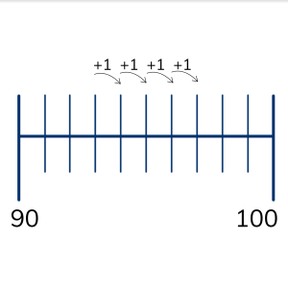
Efficiently counting to a number on the number line - within 100
Counting in jumps to a number on the number line- max 100



8,000 schools use Gynzy
92,000 teachers use Gynzy
1,600,000 students use Gynzy
General
Students learn to jump from one number to a second number to a maximum of 100 on the number line. They learn to take bigger jumps where possible, like jumping in tens and then jumping in smaller amounts.
Common core standard(s)
-K.CC.A.1
-K.CC.A.2
-K.CC.A.3
Relevance
It is important to be able to count in jumps from one number to the next so you can quickly count how many more you need to reach the second number.
Introduction
The interactive whiteboard shows a number line to 100 with the letters A, B, C, and D. The numbers 62, 36, 58, and 73 are given. The students must decide which letter belongs with each number. Erase to show the answers. Ask students how they figured out which letters and numbers belonged together, seeing as only the numbers 0 and 100 are shown on the number line. Explain that you can't see exactly which number is where, but that you approximate placement of the numbers, and use your knowledge of bigger and smaller numbers.
Development
Explain that it is important to be able to count in jumps on the number line from one number to another, because you can quickly see how many more you need to reach the second number. The interactive whiteboard has a number line that starts with 20, and you are asked to jump to 50. Explain that you will look to see how many more you need to add to 20 to reach 50. You can do this in 3 jumps of 10, but also in smaller or bigger jumps. Next practice with determining jumps from 34 to 70 and 48 to 63. Emphasize that when a number goes beyond a tens, that it is useful to jump to the next ten and then continue counting.
To check that students understand counting in jumps to a number on the number line, you can have students do the exercises of jumping from 25 to 40 and from 67 to 91 and ask the following questions:
- How can you count in jumps to a number?
- If your number goes beyond a ten, what is a useful trick?
- How do you jump from 25 to 40?
Guided practice
The students first practice jumping from one tens number to another tens number, then from a tens number to a random number, and finally from a random number to another random number. They can determine the size of the jumps themselves. Encourage them to take big jumps whenever possible, and to work to tens numbers so they can skip count by tens.
Closing
Repeat the importance of being able to count in jumps on the number line and check that students understand to make easy jumps when possible using tens or fives. Next ask students to jump from 38 to 60. The students can jump along with the counting. Have them make a big jump for jumps of ten and little jumps for smaller jumps. Repeat this for jumping from 79 to 92.
Teaching tips
If a student has difficulty counting in jumps to a number on the number line, you can have them practice placing random numbers to 100 on the number line. You can also have them make a number line to 100.
The online teaching platform for interactive whiteboards and displays in schools
Save time building lessons
Manage the classroom more efficiently
Increase student engagement
Discover more!
About Gynzy
Gynzy is an online teaching platform for interactive whiteboards and displays in schools.
With a focus on elementary education, Gynzy’s Whiteboard, digital tools, and activities make it easy for teachers to save time building lessons, increase student engagement, and make classroom management more efficient.



